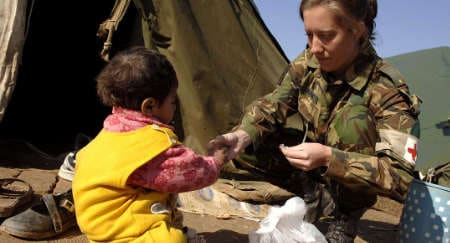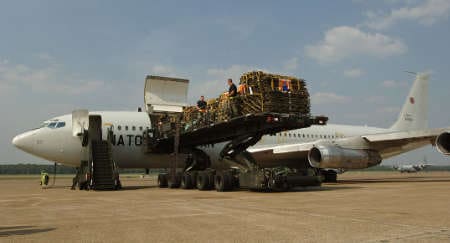James V. Arbuckle examines civilian-military conflict in humanitarian operations.

Pakistan, 2006: A Dutch nurse from the NATO Military Relief Hospital at Chaklala Air Base distributes sweets to a young earthquake victim in the camp of the "Humanity First" relief organisation (© SHAPE)
There has been a haunting failure of military and civilian agencies to develop reliable and efficient relationships over the past 50 years. In fact, peacekeeping operations have not greatly evolved since their modern inception following the Second World War.
Nor have they come very far since their supposed renaissance in the aftermath of the Cold War. This problem is especially acute in humanitarian peace operations, which have sometimes been accompanied or preceded by military deployments.
A changing role for a changing environment
The role of the military has evolved from the relatively simple military mandate of the era of 'classical' peacekeeping as envisaged by Chapter VI of the United Nations (UN) Charter. There, the mandate was to observe, or to preserve, something that already existed: a cease-fire line, a zone of separation, a withdrawal line, a green line, a de-militarised zone. Missions required the consent of the conflicting parties. The use of force was limited to self-defence, an 'inherent right' specified in Article 51 of the Charter.
This role began to change during the 1974 crisis in Cyprus. Up to then, the military had had the peacekeeping field almost entirely to themselves. Since 1964, the mandate of UNFICYP (United Nations Force in Cyprus) had consisted of only three points: to prevent a recurrence of fighting, to promote law and order and to contribute to a return to normal conditions.
That all changed in the aftermath of the Turkish invasion in 1974. UNFICYP was flooded with internally displaced persons, who posed an urgent humanitarian situation. Responsibility for the relief of this emergency was initially assigned to UNFICYP.
If the military are to function in humanitarian operations, their capabilities and their limitations must be clearly understood by their civilian partners
This was - and remains - the only amendment to the UNFICYP mandate in 40 years. Eventually the leading role was assumed by UNHCR (United Nations High Commissioner for Refugees). And the military function was gradually transformed into one of support, rather than leadership.
As post-Cold War peace operations have evolved, most interventions have been peace enforcement operations authorized by the UN Security Council under Chapter VII of the Charter. This mandate for 'wider peacekeeping' implies that force may be used to achieve the mission and that all the parties may not consent to the mission or its conduct.
So in today's paradoxical pairing of humanitarian with enforcement operations, the military is asked not to maintain a status quo but to create one. This is often euphemistically described as creating a 'positive security environment', necessary for civilian agencies to conduct their operations safely and effectively.
A soldier's dilemma?
But 'armed force' may mean different things to the military, to troop-contributing governments, to civilians and civilian agencies, and to public opinion.
In a peace enforcement operation that was in many ways a prologue to 'modern' operations, the UN Force in the Congo in 1960 (ONUC), posed questions still unanswered. Karl von Horn, the Swedish UN Force Commander, highlighted some of them in his writings:
"The physical difficulties of sticking to the rules of peacekeeping became sharply apparent . Our orders were specific: force was to be used only in self-defence, nor were we allowed any latitude, however threatening the situation. . orders like these present a commander with a distinct moral problem: whether to risk his men's lives by involving them in a situation where some of them are bound to get shot before having a chance to defend themselves - or whether to risk the failure of a mission (on whose success the lives of many civilians may depend) through a reluctance to expose his soldiers to what he considers an intolerable degree of risk," he wrote.
Despite more recent experiences with enforcement operations in Bosnia, Somalia, and Rwanda, there are still no satisfactory answers to this fundamental question first posed nearly 50 years ago.

United States, 2005: A NATO Boeing 707 unloads cargo during NATO's first shipment of relief supplies to victims of hurricane Katrina (© SHAPE)
The military cannot be all things to all people. If properly structured and deployed, it can offer protection, communications, logistic support, emergency medical treatment and evacuation, and robust coordination and control facilities. All these are critical in the earliest stages of a complex emergency response.
What the military cannot do effectively is re-settle returning refugees - and soldiers often have a healthy aversion to law enforcement tasks. Generally, direct intervention in relief efforts is not the best use of the military.
Above all, military force cannot be used offensively in humanitarian operations by 'fighting through' supply convoys. The military role will be defensive in nature: to deter armed aggression and to protect unarmed humanitarian workers if aggression occurs. But the military should not normally be employed to deliver the supplies themselves.
Modern civil-military relations challenges
Ironically, it is just when the military are unable to establish a positive security environment that they may be drawn into tasks more proper for civilian agencies. There is evidence that this is now happening to coalition forces in Iraq. As a recent report by an officer who has visited Iraq says:
'Iraq remains a semi-hostile environment. Civilian employers have a duty of care for their staff and many of the international organizations and NGOs (Non-governmental organizations) have decided to stay away. Coalition forces, therefore, have a very significant role at present in Iraq's reconstruction, rather than just in its security.'
And all this is no doubt being played out to the intense displeasure of all concerned: the military being resentful of the extension of their roles, with the civilians equally resentful of what they consider poaching.
Another example occurred in East Timor, where military medics secured, restored and returned to service a Médecins Sans Frontières (MSF) hospital. Unfortunately, returning MSF staff could not work alongside military personnel. Unthanked, the military left the hospital to the civilians.
In Iraq, as then in East Timor, it is likely that neither the civilians nor the military will see that the soldiers simply did what needed to be done. Despite their success, it was 'no job for soldiers.' These roles, which the military might have assumed out of urgent need, will not pass easily back to the civilians when (and if) the time comes.
So experience does not provide answers to many questions, such as the definition of force and especially determining how appropriate it is in each situation. There is no line where the military supports civilian agencies on one side and competes with them on the other.
Mutual trust remains elusive. The military can see themselves as being subjected to an endless round of Monday morning coaching by agencies. And they see these same agencies as the ones who have been unable to define clear roles for each side, despite this being the subject of international controversy for a generation. On the other hand, civilians often only grudgingly admit the necessity of a military role in humanitarian projects because 'only a soldier could do it.'
Bottom up cooperation, which depends almost entirely on transient personalities, is fragile, episodic and has little longevity
he situation is not so different from the one described by Dag Hammarskjöld, who began his second term as UN Secretary General 50 years ago. He said simply: 'It's no job for a soldier, but only a soldier can do it'
What next?
Much remains to be done to define military roles in support of humanitarian operations. The use of force, the importance of consent in enforcement operations, and the inter-relationship of these two factors, will continue to cause unease among, and between, the military and its civilian partners. Complicating factors include:
- the presence of the major powers' military forces;
- the roles and capacities of major regional organizations;
- and the relationships of international, regional, governmental and non-governmental organizations.
Cooperation among agencies and organizations must be initiated at the highest levels. Bottom up cooperation, which depends almost entirely on transient personalities, is fragile, episodic and has little longevity.
'Grass roots' learning is seldom transportable to a new mission, even when the new mission is staffed with experienced persons. It is common that cooperation in a new mission, despite the collective experience levels of the members of the various organizations and agencies, is very slow to develop.
Prejudices and cultural conflicts are often central to the conflicts the international community hopes to resolve. Importing similar conflicts of our own is neither professional nor workable. If the military is to function in humanitarian operations, their capabilities and their limitations must be clearly understood by their potential partners.
This will be most effectively accomplished by training, education, and relationship-building. This is the best way for us to move beyond differences to a point where similarities produce cooperation, instead of competition.
In a democracy, the military does not design policy - it executes it. A political and diplomatic failure to resolve these issues means that civilian and military workers must rise to these challenges on the streets and in the fields of conflicts.
This is asking quite a lot. Without empathetic, trusting relationships, it is asking the nearly impossible.
So, in short, it is not surprising that civil-military coordination does not work better. In fact, it is amazing that it works at all.
